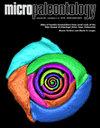Systematics, age, paleoecology and paleobiogeography of Middle to Late Jurassic benthic foraminiferal assemblages from Jumara Dome, Kutch, Gujarat, India
IF 1.6
4区 地球科学
Q3 PALEONTOLOGY
引用次数: 5
Abstract
The studied section of the Patcham-Chari formations of Middle to Upper Jurassic rocks exposed at Jumara Dome, Kutch Basin, Gujarat, India yielded rich foraminiferal assemblages comprising 104 species, of which 49 are reported for the first time from the Indian region. The foraminiferal species are systematically described and illustratedwith the help of SEMimaging. The foraminiferal assemblages are used to interpret the age, paleoecology, and paleobiogeography. Although most of the foraminiferal species are rather long ranging, on the basis of a large number of species characteristic of the Bathonian, Callovian and Oxfordian, globally as well as in the Indian region, a Bathonian to Oxfordian age is assigned to the studied sequence. Based on the dominance of the suborder Lagenina, superfamily Nodosariacea, family Vaginulinidiae, calcareous hyaline forms, the genus Lenticulina, high Fisher’s diversity index, morphogroup J2, shallow infaunal life habit, detrivores, bacterial scavengers, and omnivores feeding strategy in the assemblages, a shallow water, near shore, open marine environment ranging from mid- to outer shelf with normal salinity and normal to well-oxygenated waters with high nutrient influx is interpreted for the studied assemblages. The Middle to Late Jurassic Jumara foraminiferal assemblages are assigned to a separate province of the Antiboreal Realm, the Indo-East African Province, located at the southern margin of the Tethyan Realm and transitional between the Tethyan and the Antiboreal realms.印度古吉拉特邦库奇Jumara Dome中晚侏罗世底栖有孔虫组合的系统、年龄、古生态学和古生物地理学
对印度古吉拉特邦库奇盆地Jumara Dome中上侏罗统patchama - chari组进行了研究,发现了丰富的有孔虫组合,包括104种,其中49种为印度地区首次报道。在半成像的帮助下,系统地描述和说明了有孔虫物种。有孔虫组合被用来解释时代、古生态和古生物地理。虽然大多数有孔虫物种分布范围较长,但根据全球以及印度地区的大量Bathonian, Callovian和oxford的物种特征,将所研究的层序划分为Bathonian - oxford时代。基于Lagenina亚目、Nodosariacea超科、Vaginulinidiae科、calcalhyaline形态、Lenticulina属、高fishericoss多样性指数、形态群J2、浅水动物生活习性、腐食动物、细菌食腐动物和杂食动物的摄食策略,在浅水、近海岸,所研究的组合解释了从中陆架到外陆架的开放海洋环境,盐度正常,正常到富氧,高营养物流入。中至晚侏罗世Jumara有孔虫组合被分配到Antiboreal领域的一个单独的省,印度-东非省,位于特提斯王国的南缘,是特提斯和Antiboreal领域之间的过渡。
本文章由计算机程序翻译,如有差异,请以英文原文为准。
求助全文
约1分钟内获得全文
求助全文
来源期刊

Micropaleontology
地学-古生物学
CiteScore
3.20
自引率
6.70%
发文量
18
审稿时长
>12 weeks
期刊介绍:
The Journal of Micropalaeontology (JM) is an established international journal covering all aspects of microfossils and their application to both applied studies and basic research. In particular we welcome submissions relating to microfossils and their application to palaeoceanography, palaeoclimatology, palaeobiology, evolution, taxonomy, environmental change and molecular phylogeny. Owned by The Micropalaeontological Society, the scope of the journal is broad, demonstrating the application of microfossils to solving broad geoscience issues.
 求助内容:
求助内容: 应助结果提醒方式:
应助结果提醒方式:


